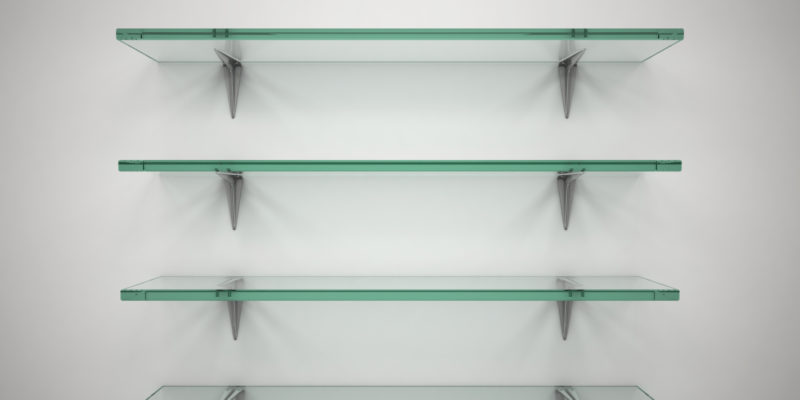If you are looking for storage that makes a clean, clear style statement, you’re probably considering glass shelves.
As stylish as they are practical, glass shelving units can be as much of a design decision as a storage solution. They maximise the space and light in a room, while still giving a sturdy, supportive surface to show off your belongings.
Unfortunately, wood often seems the safer, simpler option but this is rarely actually the case. So, we’ve put together a handy guide to glass shelving units, tackling some of the most common queries people ask.
Are glass shelves tempered?
When creating bespoke glass shelves, it is always best to use glass that has been toughened or ‘tempered’.
In order to temper glass, it is heated to an intense heat then rapidly cooled by subjecting it to blasts of cold air. This process puts the inner layers of the glass under a higher level of stress than the outer layers. This makes it a lot stronger: in fact, tempered glass can be up to 4x as tough as untreated glass.
Tempered glass is also safer, because it breaks differently. It shatters completely into crumb like pieces with no sharp edges or shards.
You are not legally required to use tempered glass when making shelves. However, here at KLG glass we use tempered glass for all our glass shelves because it is so much stronger and so much safer to do so.
How thick do glass shelves need to be?
There is no specific thickness that glass shelves need to be: it all depends on how much weight you want them to hold.
As a minimum, tempered glass shelves should be at least 4mm thick. This is fine for bathroom or other low usage shelves, that won’t need to hold more than a couple of shampoo bottles or a mug for your toothbrush.
For most purposes 8 or 10mm are a better bet. These can support heavier loads, but aren’t too costly.
Can glass shelves be recycled?
Tempered glass can be difficult to recycle. It has a different chemical make-up to untreated glass, which gives it a higher melting point. The recycling process for glass involves melting it all down, so if tempered glass is mixed in with untreated glass, you can be left with semi-solid globules of glass amongst the melted liquid.
You may be able to find specialists who can take tempered glass, but you can’t just chuck it in your usual council recycling bin when you’ve finished with it.
How do you install glass shelves?
Installing glass floating shelves is not a complicated task. If you are fixing them to a wall, use anchors to secure them. These will include a ‘clamp’ section to fit around the surface of the shelf.
Specially designed wall anchors will help make your shelving secure, as well as preventing damage to the surface of your shelves. You will need sufficient anchors for the length and width of your individual shelves.
Can glass shelves hold books?
As long as the glass has been tempered, there is no reason for glass shelves to be unable to hold books. It is all dependent on the thickness of the glass you use and how many brackets you use to secure the shelves to the wall.
How are glass shelves measured?
Like most DIY items, glass shelves can be measured in inches or in millimetres. These units can be applied to the length, thickness or depths of the shelves though obviously millimetres allow for the most amount of specificity.
Most manufacturers will offer glass shelves made to measure, allowing you to specify exactly what length and depth you want, and giving you glass shelving cut to size.
How do you attach a glass shelf to a mirror?
If you are looking for stylish storage options, few things beat a glass shelf/mirror combination. It’s all clean lines and reflected light!
For thinner shelves, like lightweight glass bathroom shelves, your best option is to bond the shelve straight on the mirror. This gives a great, clean, finish, but you will be limited on the load you can place on the shelf.
Alternatively, you can use brackets for glass shelving. These give you more flexibility on what you can put on the shelf but it can be a fiddly process that damages the mirror if done incorrectly. It’s best to get these attached by a professional.
How much weight can a glass shelf hold?
Throughout this FAQ we’ve discussed the different factors that affect how much weight a glass shelf can hold. If you need more guidance, there are plenty of weight load calculators online that can give you specific details.
How long can a glass shelf be?
Technically, there are no more limits on the length of glass shelving units than there is on wooden ones. Just remember that the longer the shelves are, you will need more brackets to keep them sturdy. For really long shelves, you may even need to consider thicker glass.
Can glass shelving be painted?
It is definitely possible to get a painted finish on glass shelving, that is glossy and durable. Thing is, we think the main attraction of glass is their light and space enhancing clarity, and a layer of paint can ruin that.
Instead, if you’re looking for ways to make your shelves more unique, why not consider getting them sandblasted or tinted. Smoky grey or black glass shelves could add depth to a room without completely sacrificing the transparency of the surface.
The clean cut lines of glass shelving can turn a practical necessity into a design feature. We hope this post has demonstrated how durable, how practical, glass shelves are, while also being the most attractive, modern choice.

